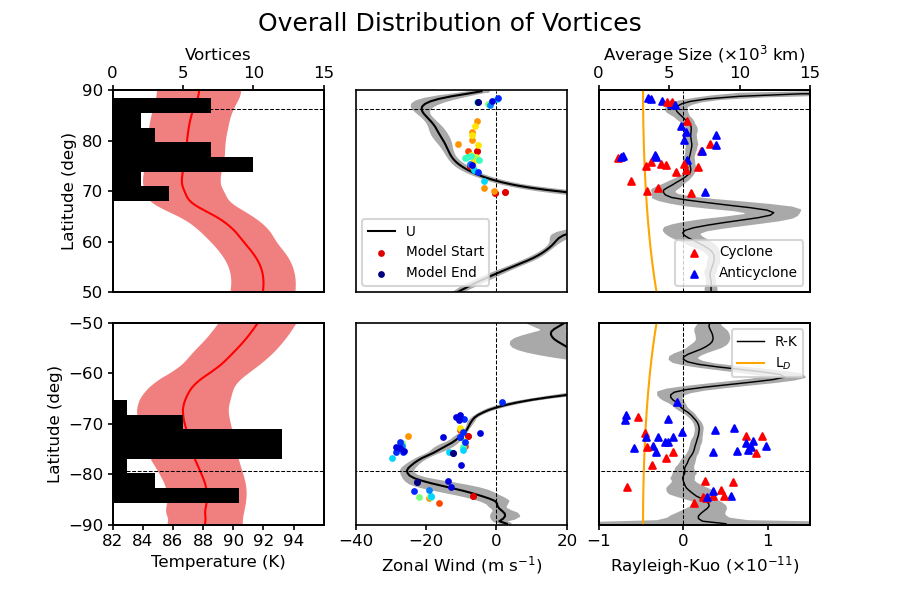- 1Laboratoire de Météorologie Dynamique, Sorbonne University, Paris, France
- 2Planetary Science Group, University of Leicester, Leicester, UK
Abstract
The Saturn DYNAMICO Global Climate Model (GCM) is a high-resolution, multi-annual numerical simulation of Saturn’s atmospheric dynamics [1], combining a radiative-convective equilibrium model [2] and a hydrodynamical solver on an icosahedral grid. The model reproduces well the observed behaviour of jets and eddy-momentum transfer to the mean flow. Vortices arise naturally in the model over time but until now they have not been given direct consideration.
Analysis of large-scale vortices in the GCM is performed by investigating; (1) the long-term statistical distribution and organization of vortices and (2) the short-term evolution of individual discrete features. The metrics used in both studies provide direct comparison to observations, albeit with some methodological differences.
Long-term analysis
This study uses a vortex selection method similar to previous observational studies of Jupiter and Saturn [3, 4, 5, 6]. We seek to address whether the Saturn GCM replicates the hemispheric symmetries and asymmetries of vortices measured on Saturn by [4, 5, 6], as well as studying the formation conditions and long-term temporal evolution of vortex distributions.
Those studies collectively observe Saturn intermittently over roughly one half of a Saturnian year between northern winter and summer solstice. The Saturn GCM offers a much-expanded view with a timeseries spanning three full model years after spin-up (to be extended further by four years), with vortex measurements obtained at each seasonal peak.
The model offers consistent spatial resolution across each global map throughout the timeseries (½-degree latitude-longitude bins corresponding to ~10-500 km/pixel from pole-equator). It constrains well the size and location of vortices, the horizontal wind field components and the magnitude and sign of horizontal vorticity.

Figure 1: Overall distribution of high-latitude vortices at ~700 mbar level for entire timeseries. (Left) histogram of vortex count with mean atmospheric temperature in red. (Centre) instantaneous zonal wind speed at the vortex centre with the mean zonal wind profile. (Right) average vortex size (average of major and minor axes) and vorticity sign with Rossby deformation radius (LD, orange) and the Rayleigh Kuo-criterion for barotropic instability (R-K, black). Mean profiles are averaged over the entire timeseries and shaded areas represent one standard deviation between all individual profiles.
Short-term analysis
This method is also applied to short term model outputs to investigate the appearance and disappearance, lifetime vs. size relationship, latitudinal and longitudinal drift and merging events. This analysis allows for the tracking of “ambiguous blobs” of vorticity with a cadence of 1 model day to study the thermal and dynamical conditions related to cyclogenesis and vortex evolution. This also provides insights into vortex behaviour and the proximity interactions with the local flow, jets, and other vortices.
Summary and Conclusions
The long-term analysis reveals that the Saturn GCM can largely replicate well the trends seen in previous observations. Some disagreement with the data can be explained methodologically. Otherwise, this presents avenues of future study like refinement of the method (employing a machine learning approach for vortex detection), inclusion of more detail in model (e.g., moist convection) and exploration of the primordial epoch of the model (for a deeper understanding of vortex behaviour in the absence of strong zonal circulations).
PTD and the France authors were supported by Agence Nationale de la Recherche (ANR) and the UK author acknowledges the Science and Technology Facilities Council (STFC).
References
[1] Spiga et al. (2020), Icarus, 335, http://dx.doi.org/10.1016/j.icarus.2019.07.011.
[2] Guerlet et al. (2014), Icarus, 238, https://doi.org/10.1016/j.icarus.2014.05.010.
[3] Li et al. (2004), Icarus, 172, https://doi.org/10.1016/j.icarus.2003.10.015.
[4] Vasavada et al. (2006), J. Geophys. Res. Planets, 111, https://doi.org/10.1029/2005JE002563.
[5] Trammell et al. (2014), Icarus, 242, https://doi.org/10.1016/j.icarus.2014.07.019.
[6] Trammell et al. (2016), J. Geophys. Res. Planets, 121, https://doi.org/10.1002/2016JE005122.
How to cite: Donnelly, P., Spiga, A., Guerlet, S., and James, M.: Statistical Analysis of Large-Scale Vortices in the Saturn DYNAMICO GCM, Europlanet Science Congress 2021, online, 13–24 Sep 2021, EPSC2021-190, https://doi.org/10.5194/epsc2021-190, 2021.

